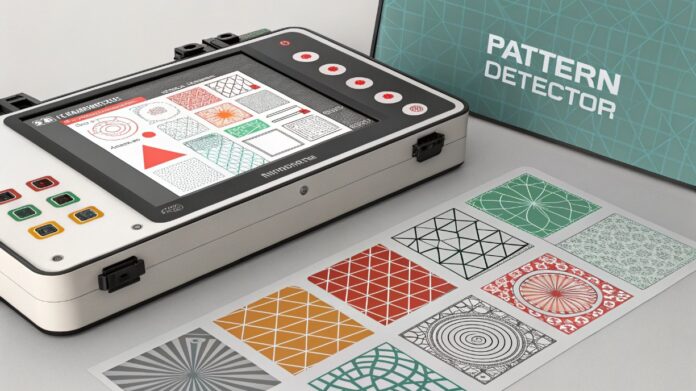Discover how a pattern detector helps find hidden trends, repetitions, & sequences in data, images, or text. Smart tool for analysis and automation.
A pattern detector is a system or tool that identifies recurring trends, shapes, or behaviors in data. Whether in technology, nature, or daily life, recognizing patterns helps us make sense of the world.
From facial recognition to stock market predictions, pattern detectors play a crucial role in artificial intelligence (AI), cybersecurity, and even healthcare. In this guide, we’ll explore what pattern recognition is, how it works, and its real-life applications in an easy-to-understand way.
What Is Pattern Recognition?
Pattern recognition is the process of identifying regularities or similarities in data. It can be done by humans or machines, like AI systems.
For example, when you recognize a friend’s face in a crowd, your brain is using pattern recognition. Similarly, a pattern detector in AI scans data to find repeated sequences, helping computers make decisions.
Key aspects of pattern recognition include:
- Detection – Finding patterns in raw data.
- Classification – Categorizing patterns into groups.
- Prediction – Using patterns to forecast future events.
How Does a Pattern Detector Work?
A pattern detector follows a structured process:
- Data Collection – Gathers information (images, sounds, numbers).
- Preprocessing – Cleans and organizes data for analysis.
- Feature Extraction – Identifies key elements (edges in images, words in text).
- Pattern Matching – Compares data with known patterns.
- Decision Making – Classifies or predicts based on findings.
This process is used in AI, security systems, and even medical diagnostics.
Types of Pattern Recognition
Pattern recognition comes in different forms:
1. Statistical Pattern Recognition
Uses math to find trends (e.g., predicting weather).
2. Structural Pattern Recognition
Focuses on shapes and layouts (e.g., fingerprint scanning).
3. Neural Network-Based Recognition
AI mimics the human brain to detect patterns (e.g., voice assistants).
4. Template Matching
Compares data with pre-stored templates (e.g., barcode scanning).
Each type has unique strengths depending on the application.
Pattern Recognition in AI
AI heavily relies on pattern detectors to learn and improve. Examples include:
- Facial Recognition – Identifies faces in photos.
- Speech Recognition – Converts spoken words into text.
- Fraud Detection – Spots unusual banking activity.
AI models like deep learning use neural networks to detect complex patterns, making them smarter over time.
Real-World Pattern Recognition Examples
1. Healthcare
Doctors use pattern detectors to diagnose diseases from X-rays.
2. Finance
Banks detect fraud by spotting unusual transaction patterns.
3. Retail
Stores analyze shopping habits to recommend products.
4. Security
Facial recognition unlocks phones and enhances surveillance.
These examples show how pattern recognition impacts daily life.
Why Is Pattern Recognition Important?
Pattern recognition helps in:
- Automation – Machines perform tasks without human help.
- Efficiency – Faster data processing and decision-making.
- Accuracy – Reduces human errors in analysis.
Industries like healthcare, finance, and cybersecurity depend on it.
Challenges in Pattern Detection
Despite its benefits, pattern detectors face challenges:
- Noisy Data – Poor-quality input leads to errors.
- Complex Patterns – Some trends are hard to detect.
- Bias in AI – Training data may contain biases.
Overcoming these issues improves reliability.
Future of Pattern Recognition
Advancements in AI will make pattern detectors even smarter. Future trends include:
- Real-Time Processing – Instant pattern detection.
- Better Personalization – AI predicts user preferences.
- Enhanced Security – More accurate fraud prevention.
The possibilities are endless!
10 FAQs About Pattern Detectors
1. What is a pattern detector?
A tool that identifies repeating trends in data.
2. How is pattern recognition used in AI?
AI uses it for facial recognition, speech processing, and predictions.
3. What are common pattern recognition examples?
Fingerprint scanning, spam filters, and medical diagnostics.
4. Can humans do pattern recognition?
Yes! Our brains naturally detect patterns.
5. What’s the difference between pattern detection and machine learning?
Pattern detection finds trends; machine learning learns from them.
6. Is pattern recognition only for computers?
No, humans and animals also use it.
7. How does a pattern detector improve security?
By spotting unusual activities in networks.
8. What industries benefit from pattern recognition?
Healthcare, finance, retail, and cybersecurity.
9. Can pattern recognition be wrong?
Yes, if data is flawed or biased.
10. What’s next for pattern recognition technology?
Smarter AI, real-time analysis, and wider applications.
Conclusion:
A pattern detector is a powerful tool in AI and everyday tech. From improving security to advancing healthcare, its applications are vast. Understanding how pattern recognition works helps us appreciate its role in modern technology.


